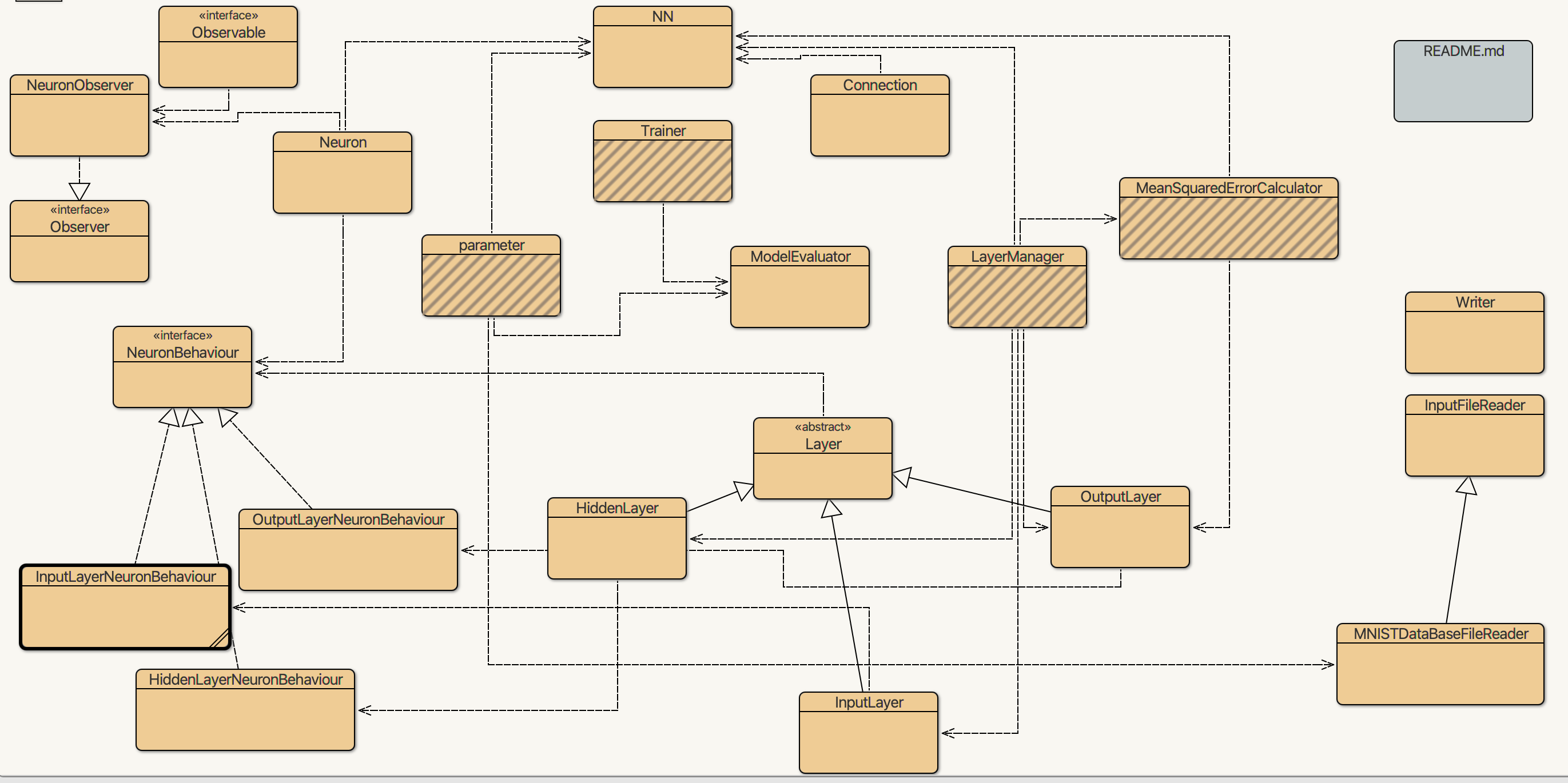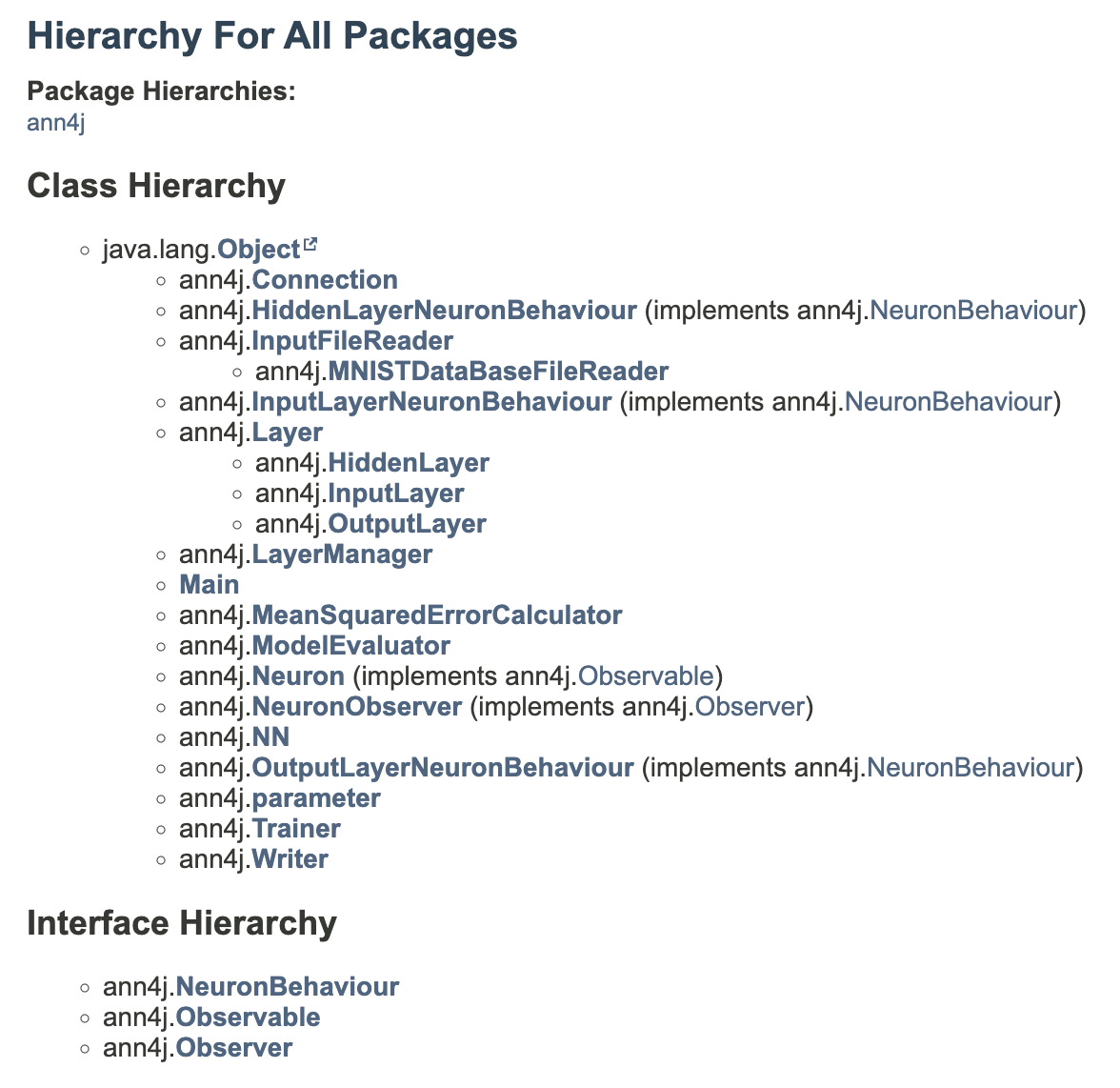#
README

#
ANN4j - Artificial Neural Networks for Java
ANN4j is a package that provides Object Oriented implementation of Artificial Neural Networks in java for exploration and analysis of neural networks and their algorithms. The package provides various functionalities for observing individual neurons and particular layers in multilayer perceptrons. Since every neuron, layer and model in ANN4j is an object of its own, implementation of new operations and algorithms on them can be done without much effort. Research on new algorithms can be done without the need for translation of the operations into matrix format. This package can be used to train models on various datasets. ANN4j provides functionality for extension of inbuilt file readers for reading from new formats of input data files. The ease of use and flexibility of this package makes it ideal for research and development of multilayer perceptrons in java.
Please consider following me on github 😄
#
READ COMPLETE DOCUMENTATION HERE
#
Source code will be found HERE
#
Table of Contents
About Features
Usage Download Requirements and Dependancies
Design Class Diagram - Clases and Methods
Design Patterns
Training Parameters Training the Model Evaluating the model Explanable AI Observable Methods Output
Data Format Default Format Other Format Constructor Getting Input Getting Label Getting Input Neuron values Getting Output Neuron values Getting prediction from the output neurons Restarting the FileReader
Documentation -Examples Other Resources
ANN4j Community Raising an issue Asking for help Community Contributing Help spread the word Cite
License Future Scope
#
About
#
ANN4j - Creating observable object-oriented neural networks for better Explainable AI.
ANN4j is a java package that provides object oriented functionality to neural networks. It implements multilayer perceptrons in java by using Objects instead of matrix multiplications. Every neuron is treated as a separate object. While this kind of implementation is highly inefficient when compared to matrix multiplications, this implementation will help research in the fields of Explainable AI. Explainable AI aims at making the model interpretable. By pausing and observing the neural net at different stages, researchers can study neural networks more efficiently. Individual observable interfaces are more easy to observe then matrices. Operations which are difficult to perform on matrices can be performed more easily using this technique.
#
Features
- Observable implementation for Artificial Neural Networks (ANN)
- XAI method for relevance propagation
- Stochastic/batch gradient descent
- No hardcoded implementations lets researchers change the parameters as they want.
- Plug and play mnist type data. Other Data files can be handled via extension.
#
Usage
To get started with ANN4j,you will need to download ANN4j from source, and import it in your workspace. No other installations required. Since the package is made using pure java, there are no other requirements or dependencies on this package.
Consider this as an pre-cooked java source code that you can directly use in your project. Just download the code from the source (link below). Place the package in a directory. Configure the path for the import statements and use it in your project! 😃
Please consider following me on github 😄
#
Download
The package can be imported after download.
import ann4j.*;
#
Requirements and Dependencies
None. This package is made using 100% Pure Java. The java package requires java 5.0+. No other requirements are required. Recommended to use the latest version of Java. Java download link
#
Design
Exaustive information can be found on our wiki
#
Inside ANN4j
ANN4j treats every neuron, weight, layer of neurons and the whole model as individual objects. Operations like forwardpropagation and backpropagation are encoded at each of these levels using superclass-subclass polymorphism. Neurons inherit special observable properties. These make it possible to observe these neurons whenever any of their parameters change. Control over the various functions has been controlled by the use of template pattern on the Trainer class by providing standard sequence of algorithms. However there is provision that any of the algorithms can be used, altered and researched upon as per requirement. The overall design of the package makes it very flexible to use. For example, strategy pattern used for neuron behaviors make it possible to add custom algorithms for setting the value of delta difference between neurons. New algorithms can be tested by inheriting class neuron and making appropriate changes in the custom implementation of algorithms. Detailed class structure, required documentation and Class Hierarchy can be found at our documentation
#
Class Diagram

#
Classes and Methods

#
Design patterns
- Strategy Pattern - NeuronBehaviour
- Observer pattern - NeuronObserver
- Template pattern - Trainer
- Singleton Pattern - NeuronBehaviour concrete classes
The following clean code principles have been applied to increase the maintainability of the package.
- Usage of composition and aggregation for increasing code quality.
- Preference to work delegation.
- Proper use of inheritance, polymorphism and interfaces.
- Explanatory variable naming.
- Short length of functions and an increase in the number of functions increases flexibility.
- Short length of classes and increase in the number of classes.
- Inline comments wherever required.
- Explanatory comments for every function.
#
Training
#
Setting parameters
Setting the output file to be output.txt and enabling command line logging.
parameter.setOutputFile("output.txt", true);Setting the number of neurons in each layer.
parameter.setLayerArray(784, 32, 16, 16, 26);Setting the training file to be emnist-letters-train.csv and the file type
parameter.setTrainingFileReader("emnist-letters-train.csv", "mnist");Setting the testing file
parameter.setTestingFileReader("emnist-letters-test.csv", "mnist");Setting the learning rate for weights
parameter.setLearningRate(1);Setting the learning rate for the bias to 1.
parameter.setBiasLearningRate(1);Setting the epsillion value for the relevance propagation algorithm.
parameter.setEpsillion(0);Setting the batch size
parameter.setBatchsize(10);Setting the rectification function.
parameter.setRectificationFunction("sigmoid");
#
Training the Model
Creating a new instance of the Trainer class.
Trainer myTrainer = new Trainer();Training the network with 88800 samples for n epochs
myTrainer.train(m, n);Creating a new instance of the NeuronObserver class this class will observe the neurons and respond when every parameter is changed.
NeuronObserver myNeuronObserver = new NeuronObserver();Testing the network with 9990 samples.
myTrainer.test(9990);Adding the neuron at layer 1 and index 31 to be observed.
myNeuronObserver.addNeuronToBeObserved(1, 31);
#
Evaluating the model
Training accuracy
myTrainer.getModelEvaluator().getTrainingAccuracy();Testing accuracy
myTrainer.getModelEvaluator().getTrainingAccuracy();Confusion Matrix
myTrainer.getModelEvaluator().printConfusionMatrix();
#
XAI
xai algorithm for relevance propagation.
myTrainer.relevancePropagate(2, 3);xai algotithm for most significant input neurons
myTrainer.forwardPropagatewithExclusionInputLayerOnKSamples(2);
#
Observable methods
In ANN4j, every neuron is an object of its own. Every Neuron can be observed by the NeuronObserver class when the values are updated. NeuronObserver class can be extended as per the requirement of the parameters to be observed. Neurons objects can also be obtined and observed independantly.
Get a neuron object from a layer.
myTrainer.getLayerManager().getLayer(layerNum).getNeuron(neuronNum));Get activation of a neuron
neuron.getActivation();Get bias of the neuron
neuron.getBias();Get arraylist of the left or right connections of the neuron
neuron.leftConnections; neuron.rightConnections;Get weight of a connection
connection.getWeight();
#
Output
Output can be seen in the file specified by the parameter class. The write class can be used to write any user defined Strings to the file.
Writer.write();This is an example of the output generated by training and observing a neuron.
Training accuracy in epoch 0 is 10.66891891891892
Testing accuracy 28.92892892892893
The neuron 31 in layer 1 has been updated by forward propagation
Neuron #31 has activation 6.567825572210979E-4
The neuron 31 in layer 1 has been updated by forward propagation
Neuron #31 has activation 0.003181628304117291
Testing accuracy 28.93314651721377
The neuron 0 in layer 2 has been updated by forward propagation
Neuron #0 has activation 0.25373727956231534
The neuron 0 in layer 2 has been updated by forward propagation
Neuron #0 has activation 0.7220061457959416
Testing accuracy 28.94736842105263
#
Data format
#
Default format
The default format for the package is MNIST format.
File type CSV consisting of the following
- 1 Label (Expected number)
- n pixel weights n must match number of input neurons.
Example
2,0,0,0,0,0,0,0,0,0,0,0,0,0,0,0,0,0,0,0,0,0,0,0,0,0,0,0,0,0,0,0,0,0,0,0,0,0,0,0,0,0,0,0,0,0,0,0,0,0,0,0,0,0,0,0,0,0,0,0,0,0,0,0,0,0,0,0,0,0,0,0,0,0,0,0,0,0,0,0,0,0,0,0,0,0,0,0,0,0,0,0,0,0,0,116,125,171,255,255,150,93,0,0,0,0,0,0,0,0,0,0,0,0,0,0,0,0,0,0,0,0,169,253,253,253,253,253,253,218,30,0,0,0,0,0,0,0,0,0,0,0,0,0,0,0,0,0,0,169,253,253,253,213,142,176,253,253,122,0,0,0,0,0,0,0,0,0,0,0,0,0,0,0,0,0,52,250,253,210,32,12,0,6,206,253,140,0,0,0,0,0,0,0,0,0,0,0,0,0,0,0,0,0,77,251,210,25,0,0,0,122,248,253,65,0,0,0,0,0,0,0,0,0,0,0,0,0,0,0,0,0,0,31,18,0,0,0,0,209,253,253,65,0,0,0,0,0,0,0,0,0,0,0,0,0,0,0,0,0,0,0,0,0,0,0,117,247,253,198,10,0,0,0,0,0,0,0,0,0,0,0,0,0,0,0,0,0,0,0,0,0,0,76,247,253,231,63,0,0,0,0,0,0,0,0,0,0,0,0,0,0,0,0,0,0,0,0,0,0,0,128,253,253,144,0,0,0,0,0,0,0,0,0,0,0,0,0,0,0,0,0,0,0,0,0,0,0,176,246,253,159,12,0,0,0,0,0,0,0,0,0,0,0,0,0,0,0,0,0,0,0,0,0,0,25,234,253,233,35,0,0,0,0,0,0,0,0,0,0,0,0,0,0,0,0,0,0,0,0,0,0,0,198,253,253,141,0,0,0,0,0,0,0,0,0,0,0,0,0,0,0,0,0,0,0,0,0,0,0,78,248,253,189,12,0,0,0,0,0,0,0,0,0,0,0,0,0,0,0,0,0,0,0,0,0,0,19,200,253,253,141,0,0,0,0,0,0,0,0,0,0,0,0,0,0,0,0,0,0,0,0,0,0,0,134,253,253,173,12,0,0,0,0,0,0,0,0,0,0,0,0,0,0,0,0,0,0,0,0,0,0,0,248,253,253,25,0,0,0,0,0,0,0,0,0,0,0,0,0,0,0,0,0,0,0,0,0,0,0,0,248,253,253,43,20,20,20,20,5,0,5,20,20,37,150,150,150,147,10,0,0,0,0,0,0,0,0,0,248,253,253,253,253,253,253,253,168,143,166,253,253,253,253,253,253,253,123,0,0,0,0,0,0,0,0,0,174,253,253,253,253,253,253,253,253,253,253,253,249,247,247,169,117,117,57,0,0,0,0,0,0,0,0,0,0,118,123,123,123,166,253,253,253,155,123,123,41,0,0,0,0,0,0,0,0,0,0,0,0,0,0,0,0,0,0,0,0,0,0,0,0,0,0,0,0,0,0,0,0,0,0,0,0,0,0,0,0,0,0,0,0,0,0,0,0,0,0,0,0,0,0,0,0,0,0,0,0,0,0,0,0,0,0,0,0,0,0,0,0,0,0,0,0,0,0,0,0,0,0,0,0,0,0,0,0,0,0,0,0,0,0,0,0,0,0,0,0,0,0,0,0,0,0,0,0,0,0,0,0,0,0,0,0,0,0,0,0,0,0,0,0,0,0,0,0,0,0,0,0,0,0,0,0,0,0,0,0,0,0,0,0,0,0,0
Here the image 2 is represented as an array of 28*28 pixels each value represents pixel activation.
Some datasets to test the package on (without extending mnist file reader)
- MNIST Handwritten database
- MNIST extended chracter database and Kaggle link
- MNIST fashion data set
- Kannada MNIST
References
#
File rendering for other formats
ANN4j provides functionality to extend the InputFileReader to add file handling for various types of datasets apart from mnist type files. InputFileReader or MNISTFileReader can be extended by making relevant changes in file reading functions.
#
Constructor
The new file reader class must pass the filename to the super constructor.
super(filename);
#
Getting input
The next() method is responsible for reading new line input from the dataset. It must also act as a super setter method. It must set all values like label , expectedOutputArray and inputArray
public void next()
#
Getting label
This method must return the label (expected value of prediction).
public double getLabel()
#
Getting Input Neuron values
This method must return the values of neurons (expected value of prediction). Example for digit recognition fo digit two, the arraylist must contain 784 elements of the pixel values.
0,0,0,0,0,0,0,0,0,0,0,0,0,0,0,0,0,0,0,0,0,0,0,0,0,0,0,0,0,0,0,0,0,0,0,0,0,0,0,0,0,0,0,0,0,0,0,0,0,0,0,0,0,0,0,0,0,0,0,0,0,0,0,0,0,0,0,0,0,0,0,0,0,0,0,0,0,0,0,0,0,0,0,0,0,0,0,0,0,0,0,0,0,0,116,125,171,255,255,150,93,0,0,0,0,0,0,0,0,0,0,0,0,0,0,0,0,0,0,0,0,169,253,253,253,253,253,253,218,30,0,0,0,0,0,0,0,0,0,0,0,0,0,0,0,0,0,0,169,253,253,253,213,142,176,253,253,122,0,0,0,0,0,0,0,0,0,0,0,0,0,0,0,0,0,52,250,253,210,32,12,0,6,206,253,140,0,0,0,0,0,0,0,0,0,0,0,0,0,0,0,0,0,77,251,210,25,0,0,0,122,248,253,65,0,0,0,0,0,0,0,0,0,0,0,0,0,0,0,0,0,0,31,18,0,0,0,0,209,253,253,65,0,0,0,0,0,0,0,0,0,0,0,0,0,0,0,0,0,0,0,0,0,0,0,117,247,253,198,10,0,0,0,0,0,0,0,0,0,0,0,0,0,0,0,0,0,0,0,0,0,0,76,247,253,231,63,0,0,0,0,0,0,0,0,0,0,0,0,0,0,0,0,0,0,0,0,0,0,0,128,253,253,144,0,0,0,0,0,0,0,0,0,0,0,0,0,0,0,0,0,0,0,0,0,0,0,176,246,253,159,12,0,0,0,0,0,0,0,0,0,0,0,0,0,0,0,0,0,0,0,0,0,0,25,234,253,233,35,0,0,0,0,0,0,0,0,0,0,0,0,0,0,0,0,0,0,0,0,0,0,0,198,253,253,141,0,0,0,0,0,0,0,0,0,0,0,0,0,0,0,0,0,0,0,0,0,0,0,78,248,253,189,12,0,0,0,0,0,0,0,0,0,0,0,0,0,0,0,0,0,0,0,0,0,0,19,200,253,253,141,0,0,0,0,0,0,0,0,0,0,0,0,0,0,0,0,0,0,0,0,0,0,0,134,253,253,173,12,0,0,0,0,0,0,0,0,0,0,0,0,0,0,0,0,0,0,0,0,0,0,0,248,253,253,25,0,0,0,0,0,0,0,0,0,0,0,0,0,0,0,0,0,0,0,0,0,0,0,0,248,253,253,43,20,20,20,20,5,0,5,20,20,37,150,150,150,147,10,0,0,0,0,0,0,0,0,0,248,253,253,253,253,253,253,253,168,143,166,253,253,253,253,253,253,253,123,0,0,0,0,0,0,0,0,0,174,253,253,253,253,253,253,253,253,253,253,253,249,247,247,169,117,117,57,0,0,0,0,0,0,0,0,0,0,118,123,123,123,166,253,253,253,155,123,123,41,0,0,0,0,0,0,0,0,0,0,0,0,0,0,0,0,0,0,0,0,0,0,0,0,0,0,0,0,0,0,0,0,0,0,0,0,0,0,0,0,0,0,0,0,0,0,0,0,0,0,0,0,0,0,0,0,0,0,0,0,0,0,0,0,0,0,0,0,0,0,0,0,0,0,0,0,0,0,0,0,0,0,0,0,0,0,0,0,0,0,0,0,0,0,0,0,0,0,0,0,0,0,0,0,0,0,0,0,0,0,0,0,0,0,0,0,0,0,0,0,0,0,0,0,0,0,0,0,0,0,0,0,0,0,0,0,0,0,0,0,0,0,0,0,0,0,0 public ArrayList<Double> getInputArray()
#
Getting Output Neuron values
This method must return the expected values of output neurons (expected value of prediction). Example for digit recognition fo digit two, the arraylist can be
0,0,1,0,0,0,0,0,0,0
This is dependant on the model and is a design decision.
public ArrayList<Double> getExpectedOutputArray()
#
Getting prediction from the output neurons
This method is used for obtaining the prediction value from the activations in the output neurons. In the digit recognitoin case as every input is mapped with same neuron it is the same. For example if neuron number 3 fires the highest, the model has predicted 3. But this needs to be overridden for different model configurations.
public double getPredictionFromNeuronNum(int mostSignificantNeuronNumAsPrediction)Note-
Predicted neuron and prediction are different.
Predicted neuron is the neuron which is most significant in firing. The prediction is the value corresponding to that neuron.
Example Consider case of handwritten letters database. If the neuron 4 is most significant (glows brightest) and it corresponds to label D then the predicted neuron is 4 and prediction is D.
getMostSignificantNeuronNumAsPrediction() is a method in LayerManager class which helps to get the value of the neuron which fires the most.
#
Restarting the file
Creates a new instance of the file reader and starts all over again.
public void restart()
#
Setting the file reader
After the file reader custom class had been made, it can be passed to the parameter class using the methods
public static void setTrainingFileReader(InputFileReader inputFileReader);
public static void setTestingFileReader(InputFileReader inputFileReader){
#
Documentation
Please visit the documentation wiki page https://aatmaj-zephyr.github.io/ANN4jwiki/
#
Examples
Example code https://github.com/Aatmaj-Zephyr/ANN4j/blob/main/Main.java
Sample output https://github.com/Aatmaj-Zephyr/ANN4j/blob/3721148ec24371bf095e1394fe39fc471f391466/output.txt
Sample output https://github.com/Aatmaj-Zephyr/ANN4j/blob/ef0f34b505e6e6316f94b5a660b9ef651582667d/output.txt
#
Other resources
- More about Artificial Neural Networks https://www.3blue1brown.com/topics/neural-networks
- Relevance propagation example https://towardsdatascience.com/indepth-layer-wise-relevance-propagation-340f95deb1ea
- Rectification functions https://www.quora.com/What-is-the-purpose-of-rectifier-functions-in-neural-networks
#
ANN4j Community
#
Raising an issue
Please feel free to suggest any changes or point out any errors by raising an issue here
#
Asking for help
For asking for clarification on any topic, raise an question issue here
#
Community
#
Contributing
Please read the contributing guidelines here. Everyone is free to contribute to this project.
#
Help spread the word
Are you using ANN4j in your research or project? If so, please let me know and I may add a link to your project or application and your logo to this repository. Also please consider starring this repository and following me.
#
Citing this package for research work
You can cite this repository using the following bibtex entry. Please update the date.
@misc{AatmajZephyr21:online,
author = {Aatmaj Mhatre},
title = {Aatmaj-Zephyr/ANN4j: Artificial Neural Networks for Java This package provides Object oriented Neural Networks for making Explainable Networks. Object Oriented Network structure is helpful for observing each and every element the model. This package is developed for XAI research and development.},
howpublished = {\url{https://github.com/Aatmaj-Zephyr/ANN4j}},
month = {},
year = {},
note = {(Accessed on <date>)}
}
#
License
MIT License
Copyright (c) 2022 Aatmaj
Permission is hereby granted, free of charge, to any person obtaining a copy
of this software and associated documentation files (the "Software"), to deal
in the Software without restriction, including without limitation the rights
to use, copy, modify, merge, publish, distribute, sublicense, and/or sell
copies of the Software, and to permit persons to whom the Software is
furnished to do so, subject to the following conditions:
The above copyright notice and this permission notice shall be included in all
copies or substantial portions of the Software.
THE SOFTWARE IS PROVIDED "AS IS", WITHOUT WARRANTY OF ANY KIND, EXPRESS OR
IMPLIED, INCLUDING BUT NOT LIMITED TO THE WARRANTIES OF MERCHANTABILITY,
FITNESS FOR A PARTICULAR PURPOSE AND NONINFRINGEMENT. IN NO EVENT SHALL THE
AUTHORS OR COPYRIGHT HOLDERS BE LIABLE FOR ANY CLAIM, DAMAGES OR OTHER
LIABILITY, WHETHER IN AN ACTION OF CONTRACT, TORT OR OTHERWISE, ARISING FROM,
OUT OF OR IN CONNECTION WITH THE SOFTWARE OR THE USE OR OTHER DEALINGS IN THE
SOFTWARE.
#
Future Scope
The future scope for the package consists of the following goals
- Implement advanced models of neural networks like -
- CNN (convolutional neural networks)
- RNN (recurrent neural networks)
- Deep learning models like LSTM – Long Short-Term Memory
- Add visualization for graphs of testing parameters.
- Add visualization of the model
- Make implementation for other dataset formats like
- Multifolder format
- Extraction of data directly from images for image processing.
#
Drawbacks of the package
Due to the technology and methods used for the package, the following drawbacks can be seen
- Slow execution of code due to Java.
- Slow execution of code due to object oriented implementation.
- High memory cost. Takes more memory when compared to matrix multiplication.
- No GPU support, all processing occurs in CPU.
- No active community.
#
Final words
ANN4j provides functionality for object oriented artificial neural networks in pure Java. It has been developed and published open source on github under the MIT license. The source code has been refactored multiple times to include clean code principles as well as relevant design patterns. This package can be used to perform fundamental research in areas of artificial intelligence as it provides flexibility due to its object oriented approach.
